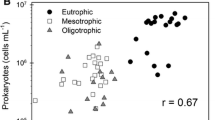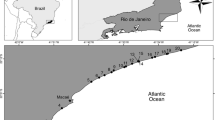Abstract
Antarctic lakes are extreme ecosystems with microbially dominated food webs, in which viruses may be important in controlling community dynamics. A year long investigation of two Antarctic saline lakes (Ace and Pendant Lakes) revealed high concentrations of virus like particles (VLP) (0.20–1.26 × 108 ml−1), high VLP: bacteria ratios (maximum 70.6) and a seasonal pattern of lysogeny differing from that seen at lower latitudes. Highest rates of lysogeny (up to 32% in Pendant Lake and 71% in Ace Lake) occurred in winter and spring, with low or no lysogeny in summer. Rates of virus production (range 0.176–0.823 × 106 viruses ml−1 h−1) were comparable to lower latitude freshwater lakes. In Ace Lake VLP did not correlate with bacterial cell concentration or bacterial production but correlated positively with primary production, while in Pendant Lake VLP abundance correlated positively with both bacterial cell numbers and bacterial production but not with primary production. In terms of virus and bacterial dynamics the two saline Antarctic lakes studied appear distinct from other aquatic ecosystems investigated so far, in having very high viral to bacterial ratios (VBR) and a very high occurrence of lysogeny in winter.




Similar content being viewed by others
References
Azam F, Fenchel T, Field JG, Gray JS, Meyer-Reil RA, Thingstad F (1983) The ecological role of water column microbes in the sea. Mar Ecol Prog Ser 10:257–263
Bell EM, Laybourn-Parry J (1999) Annual Plankton dynamics in an Antarctic saline lake. Freshw Biol 41:507–519
Bergh Ø, Børsheim KY, Bratbak G, Heldal M (1989) High abundance of viruses found in aquatic environments. Nature 340:467–468
Bettarel Y, Sime-Ngando T, Amblard C, Carrias JF, Portelli C (2003) Virioplankton and microbial communities in aquatic systems: a seasonal study in two lakes of differing trophy. Freshw Biol 48:810–822
Bettarel Y, Sime-Ngando T, Amblard TC, Dolan J (2004) Viral activity in two contasting lake ecosystems. Appl Environ Microbiol 70:2941–2951
Bratbak G, Dundas I (1984) Bacterial dry matter content and biomass estimations. Appl Environ Microbiol 48:755–757
Chin-Leo G, Kirchman DL (1988) Estimating bacterial production in marine waters from the simultaneous incorporation of thymidine and leucine. Appl Environ Microbiol 54:1934–1939
Cochran PK, Paul JH (1998) Seasonal abundance of lysogenic bacteria in a subtropical estuary. Appl Environ Microbiol 64:2308–2312
Fuhrman JA (1999) Marine viruses and their biogeochemical and ecological effects. Nature 399:541–548
Fuhrman JA, Suttle CA (1993) Viruses in marine planktonic systems. Oceanography 6:51–63
Fuhrman JA, Noble RT (1995) Viruses and protists cause similar bacterial mortality in coastal seawater. Limnol Oceanogr 40:1236–1242
Hewson I, O’Neil JM, Fuhrman JA, Dennison WC (2001) Virus-like particle distribution and abundance in sediments and overlying waters along eutrophication gradients in two subtropical estuaries. Limnol Oceanogr 46:1734–1746
Jiang SC, Paul JH (1994) Seasonal and diel abundances of viruses and occurrence of lysogeny/bacteriocinogeny in the marine environment. Mar Ecol Prog Ser 104:163–172
Jiang SC, Paul JH (1998) Gene transfer by transduction in the marine environment. Appl Environ Microbiol 64:2780–2787
Kepner RL, Wharton RA, Suttle CA (1998) Viruses in Antarctic lakes. Limnol Oceanogr 43:1754–1761
Kirchman D J (1993) Leucine incorporation as a measure of biomass production by heterotrophic bacteria. In: Kemp BF, Sherr EB, Cole JJ (eds) Handbook of methods in aquatic microbial ecology. Lewis Publishing, Ann Arbor, pp 509–512
Laybourn-Parry J (1997) The microbial loop in Antarctic lakes. In: Howard-Williams C, Lyons W, Hawes I (eds) Ecosystem processes in Antarctic ice-free landscapes. A.A. Balkema/Rotterdam/Brookfield, Rotterdam, pp 231–240
Laybourn-Parry J, Hofer JA, Sommaruga R (2001) Viruses in the plankton of freshwater and saline Antarctic lakes. Freshw Biol 46:1279–1287
Madan NJ, Marshall WA, Laybourn-Parry J (2005) Virus and microbial loop dynamics over an annual cycle in three contrasting Antarctic lakes. Freshw Biol 50:1291–1300
Maranger R, Bird DF (1995) Viral abundance in aquatic systems: a comparison between marine and fresh waters. Mar Ecol Prog Ser 121:217–226
Noble RT, Fuhrman JA (1997) Virus decay and its causes in coastal waters. Appl Environ Microbiol 63:77–83
Noble RT, Fuhrman JA (1998) Use of SYBR Green 1 for rapid epifluorescence counts of marine viruses and bacteria. Aquat Microbial Ecol 14:113–18
Ortman A, Lawrence J, Suttle C (2002) Lysogeny and lytic viral production during a bloom of the cyanobacterium Synechococcus spp. Microbial Ecol 43:225–231
Pina S, Creus A, Gonzalez N, Girones R, Felip M, Sommaruga R (1998) Abundance, morphology and distribution of planktonic virus-like particles in two high mountain lakes. J Plankt Res 20:2413–2421
Procter LM, Fuhrman JA (1990) Viral mortality of marine bacteria and cyanobacteria. Nature 343:60–62
Säwström C, Anesio A M, Granéli W, Laybourn-Parry J (2006) Seasonal viral loop dynamics in two large ultra-oligotrophic Antarctic freshwater lakes. Microbial Ecol (in press)
Steeman-Nielsen E (1951) Measurement of the production of organic matter in the sea. Nature 167:684
Steeman-Nielsen E (1952) The use of radioactive carbon (14C) for measuring organic matter in the sea. J Cons Perm Int Explor Mer 18:117–140
Steward GF, Wikner J, Cochlan WP, Azam F (1992) Estimation of virus production in the sea, I. Method development. Mar Microb Food Webs 6:57–78
Steward GF, Smith DC, Azam F (1996) Abundance and production of bacteria and viruses in the Bering and Chukchi seas. Mar Ecol Prog Ser 131:287–300
Suttle CA (1992) Inhibition of photosynthesis in phytoplankton by the submicron size fraction concentrated from seawater. Mar Ecol Prog Ser 87:105–112
Suttle CA (2005) Viruses in the sea. Nature 437:356–361
Suttle CA, Chen F (1992) Mechanisms and rates of decay of marine viruses. Appl Environ Microbiol 58:3721–3729
Suttle CA ,Chan AM, Cottrell MT (1990) Infection of phytoplankton by viruses and reduction of primary productivity. Nature 387:467–469
Tapper MA, Hick RE (1998) Temperate viruses and lysogeny in Lake Superior bacterioplankton. Limnol Oceanogr 43:95–103
Thingstad TF, Heldal M, Bratbak G, Dundas I (1993) Are viruses important partners in microbial food webs? Trends Evol Ecol 8:209–212
Weinbauer MG (2004) Ecology of prokaryotic viruses. FEMS Microbiol Rev 28:127–181
Weinbauer MG, Suttle CA (1996) Potential significance of lysogeny to bacteriophage production and bacterial mortality in coastal water of the Gulf of Mexico. Appl Environ Microbiol 62:4374–4380
Weinbauer MG, Suttle CA (1999) Lysogeny and prophage induction in coastal and offshore bacterial communities. Aquat Microbial Ecol 18:217–225
Weinbauer MG, Brettar I, Höfle M (2003) Lysogeny and virus-induced mortality of bacterioplankton in surface, deep and anoxic waters. Limnol Oceanogr 48:1457–1465
Wilcox RM, Fuhrman JA (1994) Bacterial viruses in coastal seawater: lytic rather than lysogenic production. Mar Ecol Prog Ser 114:35–45
Wilhelm SW, Brigden S, Suttle CA (1998) The role of viruses in organic carbon cycling in the sea. Eos 79;OS168
Wommack KE, Ravel J, Hill RT, Colwell RR (1999) Population dynamics of Chesapeake Bay virioplankton: total community analysis by pulsed-field gel electrophoresis. Appl Environ Microbiol 65:231–240
Wommack KE, Colwell RR (2000) Virioplankton: viruses in aquatic ecosystems. Microb Mol Biol Rev 64:69–114
Acknowledgements
This work was funded by grants from the Leverhulme Trust and Australian Antarctic Science Advisory Committee to JL-P, which are gratefully acknowledged. We are grateful to colleagues at Davis Station, Australian Antarctic Territory who assisted with fieldwork and logistics.
Author information
Authors and Affiliations
Corresponding author
Rights and permissions
About this article
Cite this article
Laybourn-Parry, J., Marshall, W.A. & Madan, N.J. Viral dynamics and patterns of lysogeny in saline Antarctic lakes. Polar Biol 30, 351–358 (2007). https://doi.org/10.1007/s00300-006-0191-9
Received:
Revised:
Accepted:
Published:
Issue Date:
DOI: https://doi.org/10.1007/s00300-006-0191-9




